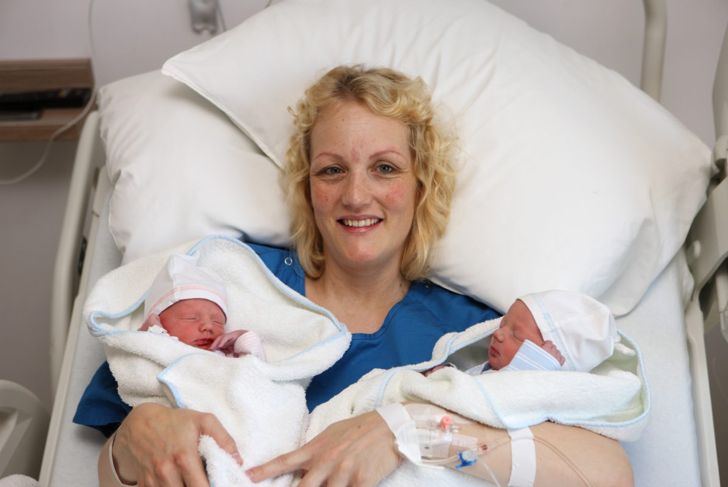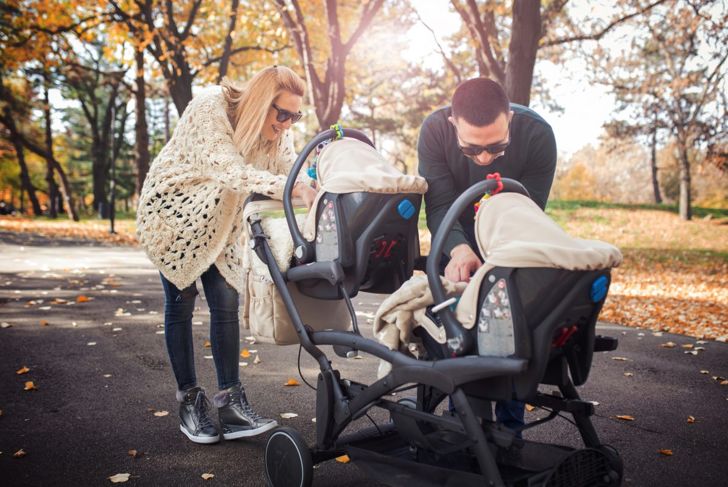In the United States, roughly one out of every 83 births is a twin birth. Of those, about 72 percent are fraternal twins. Fraternal twin births have soared since 1980, from about 19 in every 1,000 births to 33 in 2017. Part of the reason for this increase is the growing success of in vitro fertilization, which is likely to produce fraternal twins. This double helping for parents presents a unique challenge throughout pregnancy, delivery, and childhood.
Fraternal vs Identical
Identical twins result from a single fertilized egg splitting into two zygotes: they share the same genes and are always the same sex. Fraternal twins, on the other hand, result from two fertilized eggs in the same pregnancy and are essentially siblings that just happen to be born at the same time. They share half their genes, just like two children born years apart, and can be the same sex one of each.
Fraternal Twin Pregnancy
Fraternal twins are about twice as common as identical twins. They are very likely to run in families, which implies a genetic component. Fraternal twin pregnancies are thought to result from hyperovulation, when the ovaries release more than one egg during the menstrual cycle. Other factors that may increase the chance of a fraternal twin pregnancy are advanced maternal age, ethnicity, and body composition.
Signs of Twin Pregnancy
A lot of the signs of a twin pregnancy are similar to those of a single pregnancy, but they may be more intense. These include sore breasts and significant hunger and weight gain in the first trimester. Morning sickness may also be more severe. During prenatal visits, the healthcare provider may find two heartbeats or discover that the woman’s uterus is measuring larger than usual for how far along she is in her pregnancy. Bloodwork will often show elevated hCG or alpha-fetoprotein.
Prenatal Care
Prenatal care for a fraternal twin pregnancy is similar to prenatal care for a single pregnancy until the third trimester. This is primarily because each baby has a placenta and amniotic sac and gets its own nutrition and protection. In the third trimester, prenatal visits increase as the babies get bigger and delivery nears.
Weight Gain
Women who are pregnant with fraternal twins gain more weight than those carrying one baby. The recommended weight gain for fraternal twin pregnancies is between 37 and 54 pounds for women who were at a normal weight before getting pregnant. This is usually about 600 extra calories a day.
Delivery
Labor is generally the same with fraternal twins as it is with one baby. The big differences are during delivery. In most cases, delivery occurs in an operating room, even for a vaginal delivery. There is a risk that the first baby will be delivered vaginally without any problems, but that the second baby will require a c-section, particularly if they are breech.
A New Routine
Having twin newborns is stressful. The best way to adjust to having two infants is to establish a routine. While new parents are usually told never to wake a sleeping baby, that rule doesn’t apply with twins. If one wakes in the middle of the night for a feeding, experts recommend waking the other to keep them on the same schedule. Keep track of how much and how often each baby eats and needs a diaper change. That said, routines can easily get thrown off schedule. Minimizing interruptions is key, but it’s also important to roll with the punches.
Baby Gear
When it comes to baby gear, there are some things that twins can share and some things they cannot. You only need one changing table, playpen, activity center, play mat, and baby bathtub, but each infant needs their own car seat, mobile, swing, high chair, and carrier. Newborn twins can share a crib for the first few weeks, but they’ll need their own bed once they start rolling and moving around in their sleep.
Raising Twins
One of the biggest challenges of raising twins is that the siblings meet developmental milestones at the same time. Each needs their parents to respond to them in the same way at the same time. Parents may feel that they need to choose between the children and like they are not giving either the attention they deserve. This adds a lot of stress and can lead to guilt. One way to approach this is to emphasize the importance of the twin relationship itself .At all stages of development, it helps if parents honor the primary relationship between the twins.
Twin Identity and Individual Identity
Twins have two identities: as an individual and as a twin. Sometimes, the strong twin identity paired with the desire to be an individual leads to resentment and frustration. Yet twins share an attachment that begins in utero. Throughout childhood and in life, they calm each other, entertain each other for hours, and have an attachment that a single baby can never experience. Reacting to each child as an individual while understanding the value of the twin relationship is key to raising happy, healthy kids.

 Home
Home Health
Health Diet & Nutrition
Diet & Nutrition Living Well
Living Well More
More




















